上海版牛津英语二年级上册2AUnit2Asnackbar4课时英文教案
二年级英语上册Unit2Asnackbar教案(4-6)沪教牛津版

Contents
Methods
Purpose
1
This is a zoo。 What animals can you see in the zoo?
教师出示动物园的图片.This is a zoo。 What animals can you see in the zoo?
Who want to be the animals?
Post-task Activity,这是指经过机械性操练和意义性操练,引导学生运用他们所获得的知识与技能来完成一个交际性的任务“task",也就是语言的输出:output。学生通过前两个阶段的学习,在知识和能力上已具备综合新旧知识进行交际的能力,教师可以根据学生的实际水平设计或选用提供的活动,使学生在相应的尽可能贴近生活的语境中,正确有效使用习得语言,完成交际性的任务。
Activity 1 (Riddle)
1、教学辅助(Aids)
1) 图片
2.活动过程(Process)
Steps
Contents
Purpose
1
Riddle:
cake
It is round.
It is nice。
You have it on your birthday。
What is it?
以儿歌引出,激发学生的兴趣,为新课作准备。
4、在角色表演的过程中,激发学生学习的兴趣,培养学生的表演能力。
三、教学建议
1、任务前期准备阶段(Pre-task preparation section)
Pre—task Preparation是指我们要求学生运用目的语(即所学的语言)之前,呈现给学生的新语言材料。也就是我们常说的:Input。在这个环节主要让学生获得对新语言材料的第一次感知。
牛津沪教二上《Unit 2 A snack bar》word教案(4-6)

Unit 2 A snack bar第四课时(4th PERIOD)一、主要新授内容(new contents)Let’s act-- Rhyme ( I am a ______.)二、学习目标(Objectives)1、在一年级的基础上,学会用祈使语气表达意愿并理解。
2、学会用不定限定词some来说明物体的数量。
3、结合本课的主题――小吃店,创设语言使用环境,学会用Have some…来表达请人吃东西的意愿及相应的回答。
4、在角色表演的过程中,激发学生学习的兴趣,培养学生的表演能力。
三、教学建议1、任务前期准备阶段(Pre-task preparation section)Pre-task Preparation是指我们要求学生运用目的语(即所学的语言)之前,呈现给学生的新语言材料。
也就是我们常说的:Input。
在这个环节主要让学生获得对新语言材料的第一次感知。
Activity 1 (Riddle)1、教学辅助(Aids)1)图片Activity 2 (Look and say)1、教学辅助(Aids)1)电脑(2A-U2-15)2)屏幕Activity 3 (Guessing)1、教学辅助(Aids)1)一小袋饼干2)一小袋糖果2、任务中期实施阶段(While-task procedure section)While-task Procedure,这是指语言技能的习得过程。
其中分为机械性操练和意义性操练两部分。
机械性操练可以让学生准确地模仿、复说新授的语言,让他们经过从模仿到识记的过程,使新知识由感知、理解、模仿直到储存。
由于本教时新授内容有词汇也有句子而且都在两个以上,在这个教学阶段也可以设计新授知识的二次或多次导入,并根据语言训练的需要设计相应的机械性操练和意义性操练。
在这种情况下,建议每项Activity形式尽可能不同,时间不要长,一个活动紧接着一个活动,容易抓住学生的注意力,维持学习兴趣。
牛津英语2a教案 Unit2 A snack bar
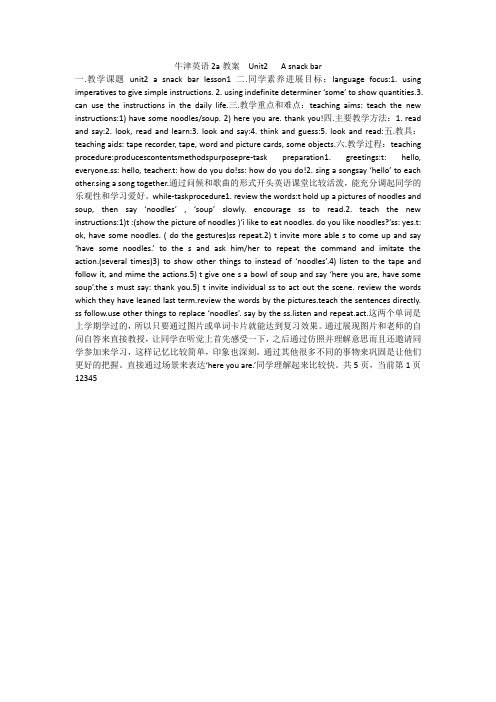
牛津英语2a教案Unit2 A snack bar一.教学课题unit2 a snack bar lesson1二.同学素养进展目标:language focus:1. using imperatives to give simple instructions. 2. using indefinite determiner ‘some’ to show quantities.3. can use the instructions in the daily life.三.教学重点和难点:teaching aims: teach the new instructions:1) have some noodles/soup. 2) here you are. thank you!四.主要教学方法:1. read and say:2. look, read and learn:3. look and say:4. think and guess:5. look and read:五.教具:teaching aids: tape recorder, tape, word and picture cards, some objects.六.教学过程:teaching procedure:producescontentsmethodspurposepre-task preparation1. greetings:t: hello, everyone.ss: hello, teacher.t: how do you do!ss: how do you do!2. sing a songsay ‘hello’ to each other.sing a song together.通过问候和歌曲的形式开头英语课堂比较活泼,能充分调起同学的乐观性和学习爱好。
while-taskprocedure1. review the words:t hold up a pictures of noodles and soup, then say ‘noodles’ , ‘soup’ slowly. encourage ss to read.2. teach the new instructions:1)t :(show the picture of noodles )‘i like to eat noodles. do you like noodles?’ss: yes.t: ok, have some noodles. ( do the gestures)ss repeat.2) t invite more able s to come up and say ‘have some noodles.’ to the s and ask him/her to repeat the command and imitate the action.(several times)3) to show other things to instead of ‘noodles’.4) listen to the tape and follow it, and mime the actions.5) t give one s a bowl of soup and say ‘here you are, have some soup’.the s must say: thank you.5) t invite individual ss to act out the scene. review the words which they have leaned last term.review the words by the pictures.teach the sentences directly. ss e other things to replace ‘noodles’. say by the ss.listen and repeat.act.这两个单词是上学期学过的,所以只要通过图片或单词卡片就能达到复习效果。
二年级英语上册 Unit2 A snack bar(1-3)教案 沪教牛津版
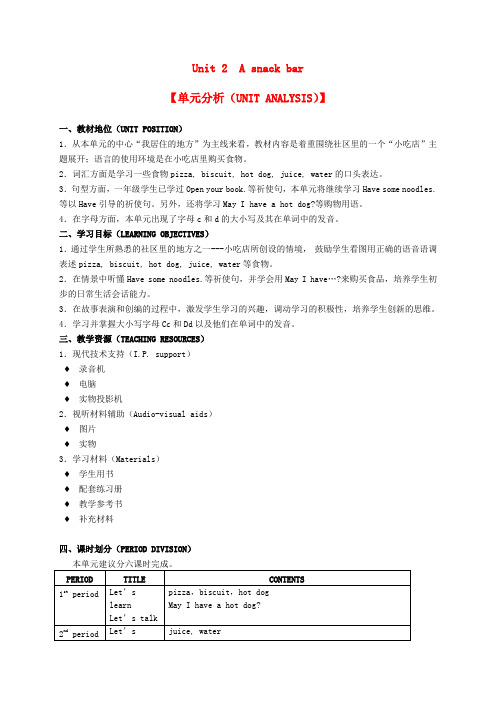
Unit 2 A snack bar【单元分析(UNIT ANALYSIS)】一、教材地位(UNIT POSITION)1.从本单元的中心“我居住的地方”为主线来看,教材内容是着重围绕社区里的一个“小吃店”主题展开;语言的使用环境是在小吃店里购买食物。
2.词汇方面是学习一些食物pizza, biscuit, hot dog, juice, water的口头表达。
3.句型方面,一年级学生已学过Open your book.等祈使句,本单元将继续学习Have some noodles.等以Have引导的祈使句。
另外,还将学习May I have a hot dog?等购物用语。
4.在字母方面,本单元出现了字母c和d的大小写及其在单词中的发音。
二、学习目标(LEARNING OBJECTIVES)1.通过学生所熟悉的社区里的地方之一---小吃店所创设的情境,鼓励学生看图用正确的语音语调表述pizza, biscuit, hot dog, juice, water等食物。
2.在情景中听懂Have some noodles.等祈使句,并学会用May I have…?来购买食品,培养学生初步的日常生活会话能力。
3.在故事表演和创编的过程中,激发学生学习的兴趣,调动学习的积极性,培养学生创新的思维。
4.学习并掌握大小写字母Cc和Dd以及他们在单词中的发音。
三、教学资源(TEACHING RESOURCES)1.现代技术支持(I.P. support)♦录音机♦电脑♦实物投影机2.视听材料辅助(Audio-visual aids)♦图片♦实物3.学习材料(Materials)♦学生用书♦配套练习册♦教学参考书♦补充材料四、课时划分(PERIOD DIVISION)Unit 2 A snack bar第一课时(1ST PERIOD)一、主要新授内容(New contents)Let’s learn -- pizza,biscuit,hot dogLet’s talk-- May I have a hot dog?二、学习目标(Objectives)1、通过学生所熟悉的社区里的地方之一---小吃店所创设的情境,培养学生初步的日常生活会话能力。
二年级英语上册 Unit 2 Period 4-5教案 沪教牛津版
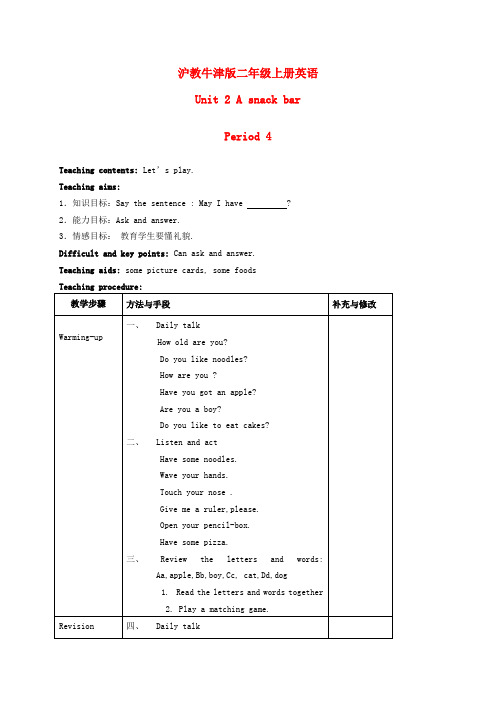
Do you like to eat cakes?
二、Listen and act
Have some noodles.
Wave your hands.
Touch your nose .
Give me a ruler,please.
Open your pencil-box.
Touch your nose .
Give me a ruler,please.
Open your pencil-box.
Have some pizza.
六、Review the letters and words: Aa,apple,Bb,boy,Cc, cat,Dd,dog
1.Read the letters and words together
2.T: Let’s learn picture one. Listen to the tape. (May I have a hot dog?)
Ask the pupils try to say it.
Work in pairs.
Eg. May I have a hot dog?
Yes, here you are.
Yes ,here you are.
Thank you.
4.T: Sam buys a hot dog and a pizza. He puts the hot dog on the table. Let’s listen what Sam says.
(Spotty!)
Ask the pupils try to say it.
Eg. Hello.
Hello.
May I have a toy rabbit?
小学二年级英语教案:Unit 2 A snack bar
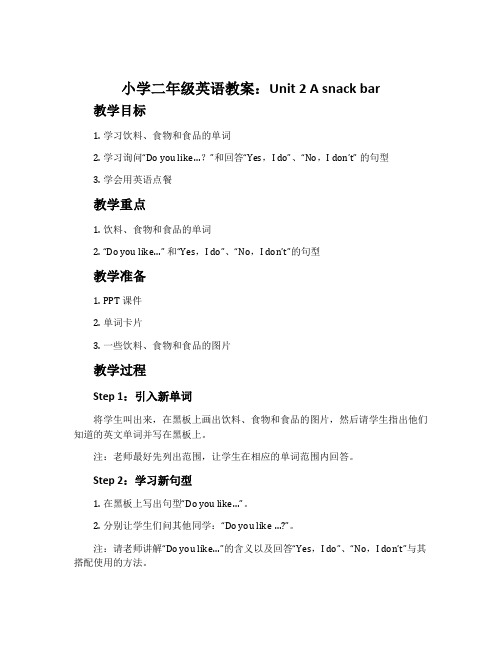
小学二年级英语教案:Unit 2 A snack bar 教学目标1.学习饮料、食物和食品的单词2.学习询问“Do you like…?”和回答“Yes,I do”、“No,I don’t” 的句型3.学会用英语点餐教学重点1.饮料、食物和食品的单词2.“Do you like…” 和“Yes,I do”、“No,I don’t”的句型教学准备1.PPT 课件2.单词卡片3.一些饮料、食物和食品的图片教学过程Step 1:引入新单词将学生叫出来,在黑板上画出饮料、食物和食品的图片,然后请学生指出他们知道的英文单词并写在黑板上。
注:老师最好先列出范围,让学生在相应的单词范围内回答。
Step 2:学习新句型1.在黑板上写出句型“Do you like…”。
2.分别让学生们问其他同学:“Do you like …?”。
注:请老师讲解“Do you like…”的含义以及回答“Yes,I do”、“No,I don’t”与其搭配使用的方法。
Step 3:练习点餐1.引导学生综合应用上述单词及句型点餐。
2.老师可以模拟一个点餐场景,学生则扮演点餐员。
Step 4:游戏环节将学生分成两组,老师念出某种食品、饮料或食物的名字,两个小组各派出一名代表,谁能先说出这种物品的英文单词,谁的小组就可以得到一分。
注:该游戏可以加强学生对单词的记忆和学习兴趣。
课程总结本节课学生通过对饮料、食品和食物的学习,掌握了询问“Do you like…”和回答“Yes,I do”、“No,I don’t” 的句型,并且通过练习点餐进一步掌握了相关单词的使用方法。
在游戏环节中,学生还加强了对单词的记忆和学习兴趣。
Unit 2 A snack bar教学设计
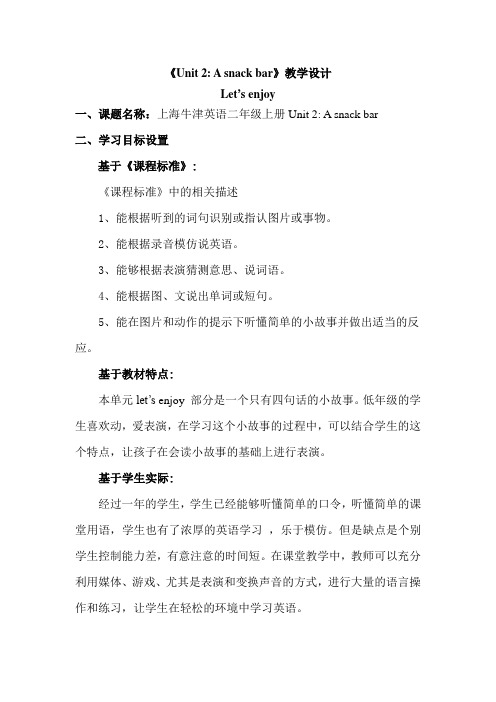
《Unit 2: A snack bar》教学设计Let’s enjoy一、课题名称:上海牛津英语二年级上册Unit 2: A snack bar二、学习目标设置基于《课程标准》:《课程标准》中的相关描述1、能根据听到的词句识别或指认图片或事物。
2、能根据录音模仿说英语。
3、能够根据表演猜测意思、说词语。
4、能根据图、文说出单词或短句。
5、能在图片和动作的提示下听懂简单的小故事并做出适当的反应。
基于教材特点:本单元let’s enjoy部分是一个只有四句话的小故事。
低年级的学生喜欢动,爱表演,在学习这个小故事的过程中,可以结合学生的这个特点,让孩子在会读小故事的基础上进行表演。
基于学生实际:经过一年的学生,学生已经能够听懂简单的口令,听懂简单的课堂用语,学生也有了浓厚的英语学习,乐于模仿。
但是缺点是个别学生控制能力差,有意注意的时间短。
在课堂教学中,教师可以充分利用媒体、游戏、尤其是表演和变换声音的方式,进行大量的语言操作和练习,让学生在轻松的环境中学习英语。
三、确定学习目标:1、结合本课的主题――小吃店,创设语言使用环境,学讲故事的过程中熟悉购物的表达方式。
2、在故事表演的过程中,激发学生学习的兴趣,调动学习的积极性。
3、在故事创编的过程中激发学生的想象,培养学生创新的思维。
四、学习重难点:1、“M y dog has my hot dog.”2、The drill of reading skills.五、教具准备:收音机、磁带、单词卡片、句子卡片、小狗头饰、小猫头饰六、评价设计:针对目标一、二,采用表演小故事的方式评价,针对目标三,采用给学生提供相关的单词参考——sweets、cakes、cat、Kitty等,让学生改编故事来评价。
七、教学过程:一、课前热身1、review some words( pizza hot dog cake sweets biscuitjelly)2、tongue twister(This is a dog. That is a hot dog. This dog is hot. That hot dog is hot. The dog likes the hot dog. The hot dog likes the hot dog.)二、新课呈现1、T: Today we’r e going to learn a story about Sam and his dog. Doyou want to know this story? Let’s listen to the tape with the question “what does Sam buy in the snack bar?”.P: hot dog、pizza2、T: Does Sam have a happy day? Why? Let’s listen to the radioagain and try to answer these questions.Students’ answer ——No, because the dog has his hot dog.3、T: Let’s learn picture one. Listen to the tape. (May I have a hot dog?)Ask the pupils try to say it.Work in pairs.Eg. May I have a hot dog?Yes, here you are.Thank you.4、T: Let’s learn pictu re two. Listen to the tape. (May I have a pizza, too?)Ask the pupils try to say it.Work in pairs.Eg. May I have a pizza?Yes, here you are.Thank you.T: Sam buys a hot dog and a pizza. He puts the hot dog on the table.Let’s listen what Sam says.(Spotty! )Ask the pupils try to say it.5、T: Do you know what the dog does? Let’s listen to the tape.(My dog has my hot dog.)T: The dog is eating Sam’s hot dog.Ask the pupils try to say: My dog has my hot dog.三、复习总结1、Act the story.a. Listen to the tape again.b.Ask the pupils try to act this dialogue. Work in pairs.c.Act it.2、Make new storys..Eg. May I have some cakes?May I have some sweets?Kitty!My cat has my cakes.八、教学反思:本节课我设置的教学目标有三个:1、结合本课的主题――小吃店,创设语言使用环境,学讲故事的过程中熟悉购物的表达方式。
二年级英语上册 Unit2 A snack bar教案 沪教版
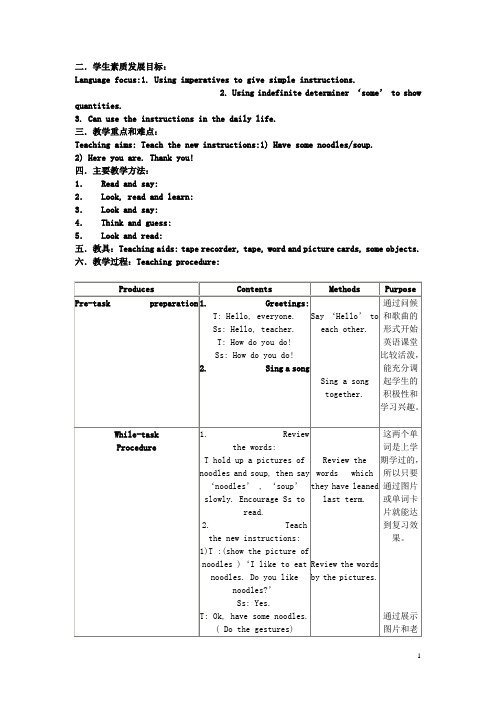
二.学生素质发展目标:Language focus:1. Using imperatives to give simple instructions.2. Using indefinite determiner ‘some’ to show quantities.3. Can use the instructions in the daily life.三.教学重点和难点:Teaching aims: Teach the new instructions:1) Have some noodles/soup.2) Here you are. Thank you!四.主要教学方法:1. Read and say:2. Look, read and learn:3. Look and say:4. Think and guess:5. Look and read:五.教具:Teaching aids: tape recorder, tape, word and picture cards, some objects.六.教学过程:Teaching procedure:教学后记:这一课时主要是Have some…句子的教授,由于过去知识的积累,这一句话对大部分学生来说是比较简单的。
所以我是直接引入教授,让学生自己朗读,之后通过各种食品的带入来巩固,并且利用游戏来配合,整堂课活泼有趣,效果明显。
一.教学课题Unit2 A snack bar Lesson2二.学生素质发展目标:Language focus: ing formulaic expressions to buy something.ing indefinite articles to refer to a particular things.三.教学重点和难点:Teaching aims: Teaching aims: 1. Teach the new words: hot dog, pizza2.Teach the new instructions: May I have…?Sure, here you are.四.主要教学方法:1. Read and say:2. Look, read and learn:3. Look and say:4. Think and guess:5. Look and read:五.教具:Teaching aids: tape recorder, tape, word and picture cards, some objects.六.教学过程:Teaching procedure:板书:教学后记:本课时是单词和句子的教授,由于单词只有少量学生很容易掌握,加上句子的教授一堂课内容还是比较丰富的,学生对于Sure, here you are.的发音不是很好,要多多练习。
- 1、下载文档前请自行甄别文档内容的完整性,平台不提供额外的编辑、内容补充、找答案等附加服务。
- 2、"仅部分预览"的文档,不可在线预览部分如存在完整性等问题,可反馈申请退款(可完整预览的文档不适用该条件!)。
- 3、如文档侵犯您的权益,请联系客服反馈,我们会尽快为您处理(人工客服工作时间:9:00-18:30)。
Unit2 Asnack bar1st periodI、Teaching Contents:Let ' searn; Let ' Salk-- May I have a hot dog?II、Teaching Aims:1、Using nouns to identify food and drinks: pizza, biscuit, hot dog, juice, water2、Using the structure to communicate with others: May I have a hot dog? Yes, here you are.3、Extend some expressions to describe food and drinks: yummy, delicious, nice, tasty, yukky111、Main points and difficult points:Using nouns to identify food and drinksIV、Materials: Picture cards, word cards, CAIV、Teaching proceduresStep 1 Pre-task preparations1.T and Ss greet each other then Ss do daily English report.2.Enjoy some part of cartoon film Disney Magic English: Delicious food3.T questions: What food do you see in the movie? What food do you like to eat? Show some food on t he screen. Ss answer and discuss in groups.4.T encourages Ss to find out her likes on food. Then lead out the new word--- pizza.5.T draws circles, triangles, olives and changes into food to elicit: biscuit, sandwich, hamburger, hot dog. Ss watch and guess whatcan it be using shapes. Then practice the new words.Step 2 While-task procedures1.T gives instruction to Ss to eat different food in different manners. Ss pretend toeat food and read the words. Make rhymes like:Pizza, pizza, big and round. Pizza, pizza, I like pizzas. Yummy, yummy, yummy!2.T puts some food or food pictures on the desk and changes it a snack bar. T and Ss make a dialogue. Encouraged by T, Ss make a dialogue with T. Then T and Ss exchange their roles and make a dialogue. E licit the new sentence structure:S:Hello! What do you like/ want?T:May I have a hot dog?S: Yes, here you are.3.Ss in pairs practice the new structure to make dialogues.Step 3 Post-task activities1.T is a shop assistant. T gives Ss commands to arrange the shelf. Ss help T to put correct food on the s helf according to T' sorder.2.T and Ss make a dialogue as a seller and a buyer. Listen to a dialogue and make a new dialogue in gr oups. Act out the dialogueRead the words aloud and make rhymes.VI、Blackboard designA snack barStep 4 AssignmentpizzabiscuitMay I have a(some) hot dogsandwichhamburgerjuice/ water/ Coke/ tea/ milkYes, here you are.2nd periodI、Teaching Contents:Let ' play, let ' enjoy11、Teaching Aims :1、Using the sentence pattern May I have •••? to get goods.2、Extended words: hot, tired, How much?III、Education Aims: Improve their abilities of cooperation with others.IV、Main points and difficult points:Using formulaic expressions to buy somethingUsing nouns to identify food and drinksV、Materials : Picture cards, word cards, CAIVI、Teaching procedureStep 1 Pre-task preparations1.Daily greeting2.T shows the pictures and review.What do you see?What do you like to eat/ drink?Ss respond.(pair work, group work, train work)3.T divides Ss into groups. Ss in groups do a survey: what do you want? Then report the shopping list to T.4.T puts the list on the Bb and asks Ss to count. Ss guess and count the number of the food. one biscuit, two biscuits, three biscuitsfour sweets, Elicit: some biscuits, some juiceStep 2 While-task procedures1.On the screen T shows some food or some real food in the snack bar. Ask Ss to count. Ss answer: Ho w many pizzas/cakes •••?2.Read their own shopping lists together.3.T is a buyer. S is a seller. Make a dialogue: May I have •••?4.Ss in groups to buy the same things to see which group is the best seller and buyer.5.Ss in pairs practice buying and selling according to the shopping list on P 10Step 3 Post-task activities1.T plays the flash story on P11. Ss repeat.2.Ss in pairs/ groups act this story.3.Group work: Make a new story.4.Order the meal in groups. See whose orders the most nutritious meal.Let ' chant: Can I have some more?Step 4 AssignmentMake a shopping dialogue with your partner.3rd periodI、Teaching Contents:Let ' act, lettersII、Teaching Aims :1、Using imperatives to give demands2、Learn the letter C DIII、Main points and difficult points:Using imperatives to give simple instructionsUsing indefinite determiner "some"to show quantitiesIV、Teaching aids: picture cards, word cards, CAIV、Teaching proceduresStep 1 Pre-task preparations1.T shows a box to Ss. T gives them some information:It is small. It has two short ears and a long tail. It can catch mice. It likes fish. It goes “Miaomiao” .Ss guess what'所it?2.New letter: Cc Read: Cc /k/ cat, learn to write3.The same input of Dd Read: Dd /d/ dog, learn to write4.Group work: Try to say more.Step 2 While-task procedures1.T lists out those food words that have Cc /k/, Dd /d/. Read these words.2.T questions: what do you like to eat? Ss answer: I like to eat ….3.They exchange. Elicit: cake, noodles Ss practice the words.4.Find out what kind of noodles Ss like to eat. Answer: I like chicken noodles, fish noodles, meat noodle s--5.T pretends to invite them to eat and elicit: Have some…Ss accept and pretend to eat and drink: Thank you. Yummy, delicious, nice.Practice the new item.6.Enjoy a rhyme. Ss can make a new rhyme.Step 3 Post-task activities1.Show kinds of food on the screen: (to eat and drink) questions: what can you eat for breakfast/ lunch/ d inner? Ss provide suitablefood to T using: Have some …for …T appreciates their offers.2.T and a good S make a model dialogue. Mum, I ' ntnome.Are you thirsty? Have some juice.Thank you, Mum. I ' ntnungry, too.All right. Have some biscuits.Oh, how nice!3.Pair work: Make a new one. Then act it out.4.Role play: T gives the different scenes: At a snack bar/ in the restaurant/ At home Group work to mak e a short play.Step 4 AssignmentsPrepare a dialogue with partners like the one in class.4th periodI、Teaching Contents:RevisionII、Teaching aids: radio, word cardsIII、Teaching proceduresStep 1 Pre-task preparations1、Review words: What' smissing? BingoGuess and match list and count2、Ask and answer: What do you like to eat/ drink? Do a survey.Step 2 While-task procedures1、Enjoy a short movie: listen, watch and find what they like. Then answer.2、According to the movie in groups make a shopping list.3、Shopping: In groups act the dialogue.4、After shopping comes a party. Do group work to serve the food: Have some•- Thank you.Step 3 Post- task activities1、Finish the exercises on <Workbook>2、Unit quiz: <Work book>。
